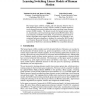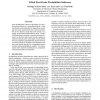UAI
1993
14 years 8 months ago
1993
We examine two types of similarity networks each based on a distinct notion of relevance. For both types of similarity networks we present an efficient inference algorithm that wo...
UAI
1997
14 years 8 months ago
1997
Bayesian networks provide a modeling language and associated inference algorithm for stochastic domains. They have been successfully applied in a variety of medium-scale applicati...
NIPS
2000
14 years 8 months ago
2000
The human figure exhibits complex and rich dynamic behavior that is both nonlinear and time-varying. Effective models of human dynamics can be learned from motion capture data usi...
NIPS
1998
14 years 8 months ago
1998
Inference is a key component in learning probabilistic models from partially observable data. When learning temporal models, each of the many inference phases requires a complete ...
AAAI
1997
14 years 8 months ago
1997
In this paper, we propose a stochastic version of a general purpose functional programming language as a method of modeling stochastic processes. The language contains random choi...
ASC
2000
14 years 8 months ago
2000
A new language and inference algorithm for stochastic modeling is presented. This work refines and generalizes the stochastic functional language originally proposed by [1]. The l...
UAI
2004
14 years 8 months ago
2004
An autonomous variational inference algorithm for arbitrary graphical models requires the ability to optimize variational approximations over the space of model parameters as well...
IJCAI
2003
14 years 8 months ago
2003
Most probabilistic inference algorithms are specified and processed on a propositional level. In the last decade, many proposals for algorithms accepting first-order specificat...
NIPS
2001
14 years 8 months ago
2001
The hierarchical hidden Markov model (HHMM) is a generalization of the hidden Markov model (HMM) that models sequences with structure at many length/time scales [FST98]. Unfortuna...
DLOG
2006
14 years 8 months ago
2006
The goal of this paper is to present how the Prolog Technology Theorem Proving (PTTP) approach can be used for ABox-reasoning. This work presents an inference algorithm over the l...



